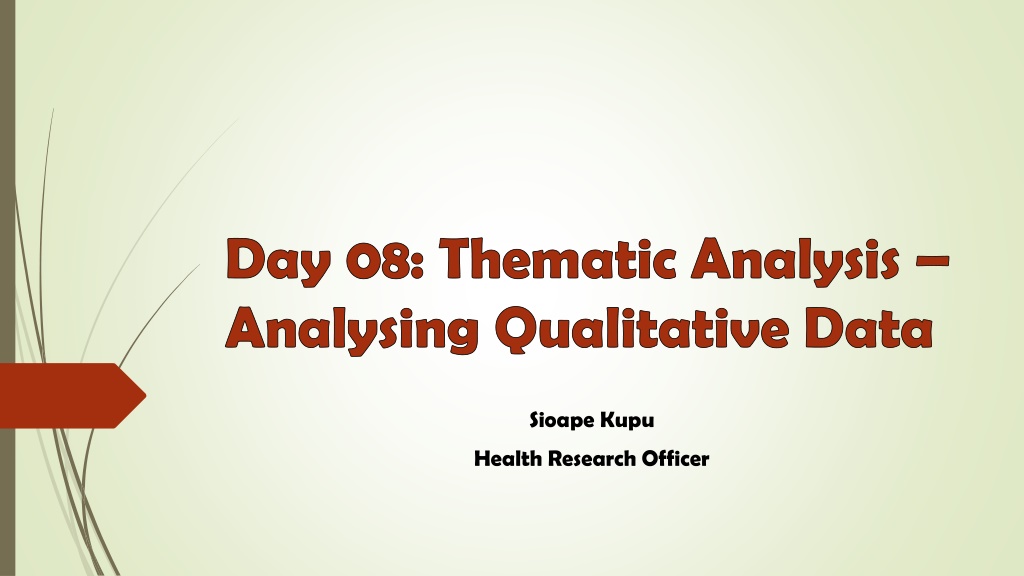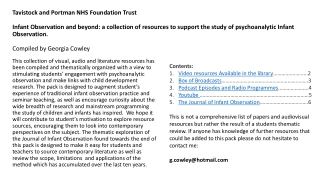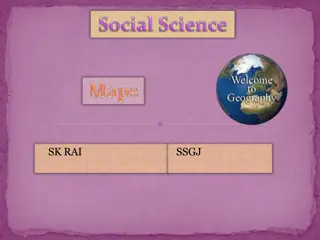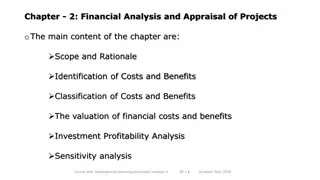Thematic Analysis: Understanding, Implementing, and Benefits
Thematic analysis is a method used to identify, analyze, and report patterns within qualitative data. It offers simplicity for novice researchers, flexibility in theoretical framework choice, and the ability to provide rich and detailed descriptions of data. The process involves steps such as intimate data analysis, theme searching and revision, finalization of themes, and writing up findings.
Download Presentation

Please find below an Image/Link to download the presentation.
The content on the website is provided AS IS for your information and personal use only. It may not be sold, licensed, or shared on other websites without obtaining consent from the author. Download presentation by click this link. If you encounter any issues during the download, it is possible that the publisher has removed the file from their server.
E N D
Presentation Transcript
Day 08: Thematic Analysis Analysing Qualitative Data Sioape Kupu Health Research Officer
Research process The 3rdand 4thstep: Design and Collecting Data involves creating your Research Methodology and Methods and then collecting the data.
Day 08 Objectives Understand the process of Thematic Analysis of Qualitative Data. Able to analyze Qualitative Data using Thematic Analysis
Thematic Analysis Braun and Clarke (2006) define thematic analysis as: A method for identifying, analysing and reporting patterns within data. (p. 79) Thematic analysis is a widely used method of analysis in qualitative research as a means of categorizing supposedly unrelated data.
Why should you use thematic analysis? Thematic analysis is simple to use which lends itself to use for novice researchers who are unfamiliar with more complex types of qualitative analysis. It allows for flexibility in the researchers choice of theoretical framework. Some other methods of analysis are closely tied to specific theories, but thematic analysis can be used with any theory the researcher chooses. Through this flexibility, thematic analysis allows for rich, detailed and complex description of your data.
Steps for Thematic Analysis 1)Get intimate with your data 2)Search for themes 3)Revise themes 4)Finalize themes and any sub- themes 5)Write up
1) Get intimate with your data Transcribe recorded interviews (if used). Transcribe/ Transcription converting audio to paper verbatim (word for word). Read and reread the data until you know the content intimately Make notes as you go about meaning, patterns, mark ideas for coding etc. Very time consuming but important
2) Search for themes Search for and identify common threads. Themes often quite abstract Can be difficult to identify Ask what are they trying to tell me Often indicated rather than directly described End of this phase you have an initial set of themes
Example Theme=Good Patient / Stoicism There were many examples of participants suggesting that they would rather put up with some pain than have it treated. P10 (M, <30, Euro, High Barrier): I just learned not to move or to put up with it. You do what you ve got to do. P10 (M, <30, Euro, High Barrier): I think it {focus on pain} has been quite good because at times I ve been in pain I ve thought can t you give me something for this, or can we do something about this, but like usually my parents would say, oh just put up with it, and I do. P1 (F, 50+, Euro, Low Barrier): {I: Do you think that people should put up with some degree of pain when they ve got an illness or injury?} No. Should implies an obligation and I don t think anyone s obliged to put up with pain. P7 (F, 30-49, Maori, Mid Barrier): I wait until I think the pain is not going way. If it just stuck to the hip it would be OK, but when it goes to my knee or my back, I think I d better go and do something.
3) Review themes Examine all data extracts for each theme Decide whether themes make sense in relation to data set If not, identify problem: Theme problematic? Some of the extracts don t fit? Recoding from data set Identify new themes
4) Finalize themes & sub themes Identify core of what theme is about Consider how each theme relates to the other themes Refine themes as necessary Identify any sub-themes Begin to firm up final names for themes Detailed analysis of each theme
Example: Opiophobia Opiophobia - refers to a phenomenon in which exaggerated concern about the risks associated with opioids prevent appropriate medical use of opioid analgesics e.g. morphine. Fear of addiction Fear of tolerance Fear of side effects Fear of losing cognitive abilities Fear of respiratory depression
5) Producing the report Each theme should be distinct but clearly link with the overall research/evaluation question Scope and diversity of each theme should be clear Questions to guide analysis: What does this theme mean? What assumptions underpin it? Why do people talk about this thing in this way? What story does the theme reveal about the topic?
Example Opiophobia 1) Fear of addiction. The fear of addiction has been identified as one of the key aspects of Opiophobia for patients exposed to the use of opioid medicine. Addiction has been identified by many participants mainly due to the notion that once you use drug of that caliber even for medicinal use, it will lead to addiction. Male Participant - The doctor said morphine will help ease the pain I don t care. I do not want to end up addicted to that ***** and end up like those addicts in rehab
Day 08 Objectives Understand the process of Thematic Analysis of Qualitative Data
Acknowledgements Dr. Rob McNeill Dr. Rob McNeill Senior Lecturer. Health Systems Lecturer. Health Systems University of Auckland School of Population Health

















































